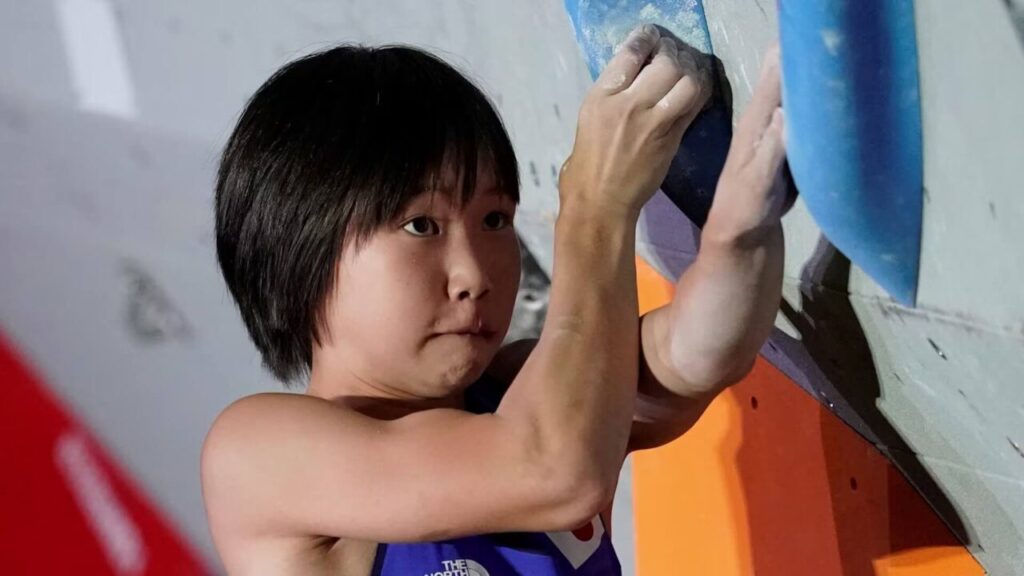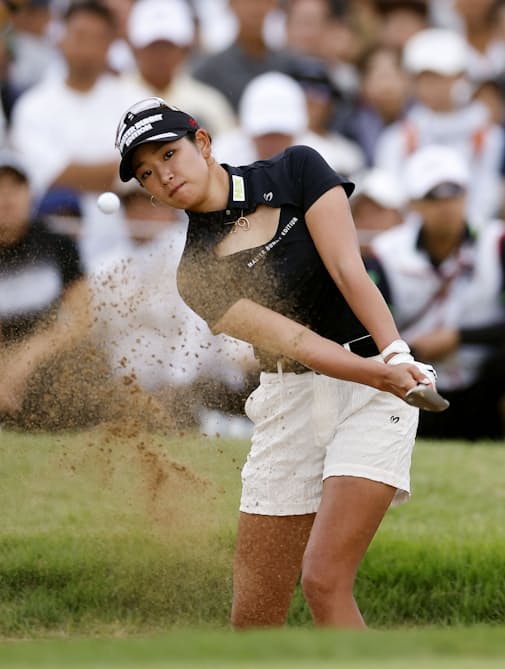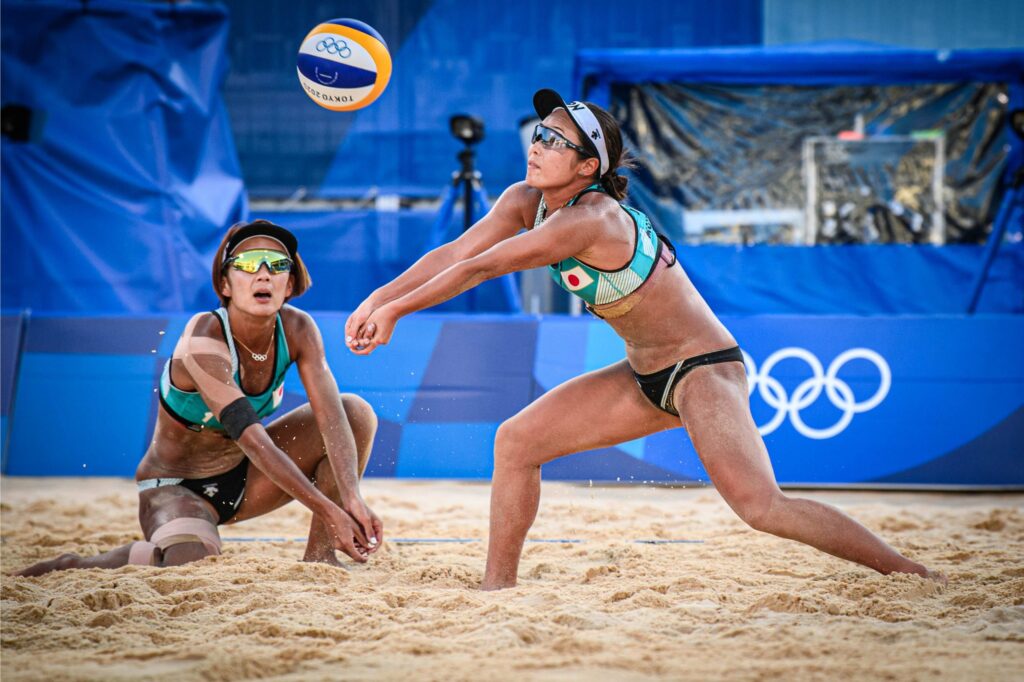
Beach volleyball is a fast-paced sport played on the sand, where skill and tactics determine the outcome.
A wide variety of skills are required to be successful, from basic techniques to application in competition.
In this article, we will explain in detail the basic techniques and tips needed to dominate the game of beach volleyball.
It starts with serving and receiving, and covers important techniques such as spiking and blocking to advance the game to your advantage.
We hope this guide provides practical advice for all players who want to hone their beach volleyball skills and take their game to the next level.
目次
Basic techniques of beach volleyball
Beach volleyball is a sport of skill and strategy, and mastering the basic techniques is the first step to success.
Here, we will focus on serve, receive, set, attack, and block as the basic techniques needed to start playing beach volleyball, and introduce the key points of each technique.
serve
The serve is the first technique to start the game in beach volleyball. A powerful and accurate serve can put pressure on the opposing team and create scoring opportunities.
- Tip : When serving, it is important to throw the ball high and forward, fully extend your arm at the moment you hit it, and hit the center of the ball. Learn different types of serves, such as floater serves and topspin serves.
receive
Receiving is the technique of receiving the opponent’s serve or attack and connecting it to your team’s attack.
- Tip : It is important to position your body correctly relative to the direction of the ball and use both arms to get under the ball. The key to making a stable reception is how you use your arms and the movement of your feet.
set
Set is the technique of sending the ball to the appropriate position for attack after receiving or digging (defense).
- Tip : When setting, use the fingers of both hands to control the ball and send it accurately to your attacking teammates. Approach the ball from the front and use your arms and wrists to push the ball up.
attack
Attack (spike) is a technique in which a set up ball is powerfully returned to the opponent’s court.
- Tip : An effective attack requires proper approach, jump, and precision in timing the ball. Be aware of the height and angle of your hitting point, and aim for areas that are difficult to defend.
block
Blocking is a defensive technique that returns an opponent’s attack to the outside of the court or places it in an advantageous position for your team.
- Point : For effective blocking, it is important to predict the movements of the opponent attacker and jump at the right time. Block by extending your arms high and blocking the trajectory of the ball.
Mastering these basic techniques will lay the foundation for success in beach volleyball.
By learning the correct form for each technique and practicing repeatedly, you will be able to improve your technique and gain a deeper understanding of the game.

Tips for effective serving
In beach volleyball, the serve is an opportunity to directly score points and is an important technique for putting pressure on the opposing team.
In particular, floater serves and jump serves are often used as effective serving techniques.
Understanding these serve tips and practices will help you take your game to the next level.
floater serve
The floater serve gets its name from the erratic movement of the ball in the air. This irregular movement is difficult for receivers to predict and can easily lead to receiving errors.
-
Tips :
- Throw the ball in front of you or slightly upwards. Keep the height constant at a position that is comfortable for you to hit.
- When hitting the ball, use your entire palm to hit the center of the ball hard. This minimizes spin and creates a float effect.
- By changing the direction and strength of the serve, you make it difficult for the opposing team to predict.
-
How to practice :
- Practice aiming your serve at different parts of the court and delivering it exactly where you want it.
- Develop a practical feel by practicing with a partner and being the receiver of each other’s floater serves.
jump serve
A jump serve is a serve that imparts powerful speed and spin to the ball from a high point of impact. This makes it difficult for the opponent to receive.
-
Tips :
- By jumping with a run-up, you can create high hits. Run-up speed and jump timing are important.
- At the moment you hit the ball, use your wrist to give it a strong snap to add rotation to the ball. This increases the speed and spin of the ball.
- Try to hit the ball as high as possible and in front of your body.
-
How to practice :
- Practice focuses on jumping and hitting height. Check your jumping form without using a ball at first, then gradually add more balls.
- We will do shadow practice in front of the net to learn correct hitting points and how to use the wrist.
- Practice repeatedly adjusting your run-up speed and jump timing to find a rhythm that suits you.
By mastering these serving techniques, you will be able to put great pressure on the opposing team and advance the flow of the game in your favor.
Correct form and practice are the keys to an effective serve.

For solid reception
In beach volleyball, solid receiving is essential to a team’s success.
If the reception is stable, it will create offensive opportunities and lead to defensive stability.
Learning proper form, proper movement, and understanding how to read the ball are important for solid receiving.
Correct receiving form
- Foot position : Feet slightly wider than shoulder width apart, knees slightly bent. This position keeps your center of gravity low and allows you to move quickly in any direction.
- Arm position : Arms extended in front of you, hands flat together. When touching the ball, try to catch the ball with your entire arm.
- Body orientation : Point your body in the direction the ball is coming from and stabilize your body under the ball. Directing your body toward the ball allows for accurate reception.
point of movement
- Prediction and positioning : Predict the server’s stance and ball trajectory, and quickly position yourself where the ball is likely to come. For this reason, it is important to constantly observe the movements of the opponent player.
- Adjust your steps : Fine-tune your position with small steps to get under the ball. Avoid big steps and always maintain balance.
How to read the ball
- Observe the server : Read the direction and strength of the serve from the server’s body direction, arm swing, and hand position. Paying attention to server behavior will help you prepare for receiving.
- Predict ball trajectory : Quickly determine the speed and trajectory of a served ball and move to the appropriate position. If the ball is high, try to get underneath it, and if it’s low, use your body to send the ball back up.
Solid receiving skills are developed through practice and experience. It’s important to be aware of correct form, communicate with your teammates, and improve how you read the ball.
By solidifying this foundation, teams will be able to build stronger attacks and stabilize their defenses.

Spike technology that increases attack power
In beach volleyball, spikes are one of the most effective means of attack to score points.
Successful spikes largely depend on your approach, jump timing, and selection of points of impact.
Here are some key techniques to help you hit more powerful and accurate spikes.
effective approach
- Speed and Rhythm : The speed and rhythm of your approach are essential to a strong spike. By taking a big last step, you can gain the strength to jump higher.
- Step pattern : The approach is usually done in 3 or 4 steps. Start with small steps and then take big steps at the end to build up maximum power for the jump.
jump timing
- Not too early and not too late : It is important to jump at the optimal moment to reach the ball. Adjust your jump timing to match the height and speed of the set ball.
- Flow from the approach : A smooth transition from the final step of the approach to the jump is the key to an effective spike. Think of the series of movements as one flow.
How to choose a dot
- High and forward : For a powerful spike, it is ideal to hit the ball as high as possible and in front of your body. This allows you to swing powerfully at the ball.
- Distance to the ball : By keeping the proper distance between yourself and the ball, you can attack from a more accurate angle.
How to use your body when spiking
- Arm Swing : Swing your arms down forcefully, using the snap of your wrist to add additional force to the ball.
- Use your whole body : Spiking uses your entire body, not just your arms. Use the power of your hips and legs to add more force to the ball.
How to practice
- Shadow Spike : Repeat the approach, jump, and swing movements without the ball. This will help you learn how to use your body and the flow of movement.
- Target practice : Use a net to practice hitting a spike at a specific location. This allows you to increase the accuracy of your attacks.
Effective spiking can be learned with practice and experience.
By mastering the basic techniques and applying them to suit your own style, you will be able to greatly improve your attack power in beach volleyball.
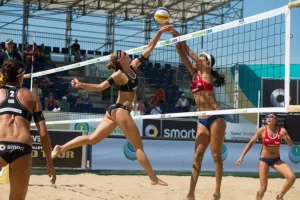
Block your opponent with a block
Blocking in beach volleyball is an important defensive technique that effectively blocks opponents’ spikes and creates opportunities to score points.
Successful blocking is highly dependent on correct positioning, timing, and hand use.
Here are some blocking tips to improve your defense.
Block position
- Get close to the net : When blocking, get as close to the net as possible, but be careful not to touch it. This allows you to effectively cut off your opponent’s spike course.
- Respond to attackers : Anticipate the location of your opponent’s attackers and the angles they are likely to hit from, and adjust your position accordingly. Decide your position keeping in mind the attacker’s hitting point.
block timing
- Read the attacker’s movements : Determine the timing of the attacker’s approach and jump, and jump accordingly. Too early and you’ll be shot down, too late and you won’t be able to block the ball.
- Pay attention to the speed of the set ball : The speed of the set also affects the timing of the block. Adapt to the situation by reacting quickly to fast sets and delaying jumps to slow sets.
How to use your hands
- Reach your hands high : Once you jump, extend your arms high and spread your hands wide to block the path of the ball. Your palms should face your opponent’s court, and you should be conscious of the shape in which you are pushing the ball back into your opponent’s court.
- Spread your fingers : Spread your fingers to increase the area covered by the net and prevent the ball from passing through. Also, by feeling the ball with your fingertips, you will be able to block more effectively.
How to practice
- Shadow block : Even if there is no ball, you can repeat the blocking motion while imagining the attacker’s movements and learn how to use your body.
- Pair Practice : Practice blocking against real spikes by practicing with a partner. Experience blocking in real-life situations while switching between attacking and defending roles.
Blocking is the key to defense in beach volleyball.
By mastering the correct positioning, proper timing, and effective use of your hands, you can thwart your opponent’s attacks and increase your team’s opportunities for counterattacks.
By practicing repeatedly, you will be able to naturally instill these techniques into your body and greatly improve your defensive abilities.

Unique beach volleyball technique
Beach volleyball has some unique techniques to match its unique play style and strategy.
Mastering these techniques will allow players to significantly improve their performance in matches and outsmart their opponents.
Below, we will introduce some of the most important techniques specific to beach volleyball.
Pokey
Pokies is a technique in which you use your fingers to push a ball. It is especially effective when the ball is high up in the air or when delicate play near the net is required.
- Tip : Use mainly your thumb and index or middle finger to push the ball lightly. This technique is used to precisely place the ball out of reach of the opponent.
Cut Shot
A cut shot is a technique in which you curve the ball and send it in a direction different from where your opponent expects it to go. It is especially effective for toying with opposing defenders.
- Tip : Hit the ball so that it cuts diagonally forward at the point of impact. Using this technique, you can avoid blockers and send the ball out of reach of defenders.
Sky Ball Serve
Skyball serve is a technique in which the ball is served very high, primarily using the wind to confuse the opponent.
- Tip : Throw the ball directly up high and serve it so that it launches strongly from below. The served ball is affected by the sun and wind, making it difficult to predict.
Second Ball Attack
A double attack is a technique in which the setter directly attacks the opponent’s court with his second touch. It is effective as an attack that is difficult to predict.
- Tip : When using this technique, you can feign a set and turn into a sudden attack, allowing you to hit the opposing team’s off-guard.
These techniques unique to beach volleyball are powerful tools that can change the course of a match.
By using each technique appropriately depending on the situation, you can launch unpredictable attacks on the opposing team and advance the match to your advantage.
These techniques can be acquired with practice and experience, so be proactive in your training.

Understanding beach volleyball tactics
In beach volleyball, the outcome of a match is determined not only by advanced technique but also by the understanding and application of tactics.
By using effective tactics, you can exploit your opponent’s weaknesses and make the most of your team’s strengths.
Below you will find some tactical advice that you can use in your beach volleyball match.
Analyze your opponent’s weaknesses
- Individual player analysis : Observe the skills and characteristics of each player on the opposing team and find their weaknesses. For example, identify players whose reception is unstable or players who are weak at blocking, and target them with attacks.
- Weaknesses as a team : Look for weaknesses in the opposing team’s tactics and coordination. For example, there are empty spaces between the block and the defense, and positioning issues when receiving serve.
Leverage your team’s strengths
- Use your special skills : Make use of your team members’ special skills and playstyles. Make the most of your strong spikes and serves to put pressure on your opponent.
- Strengthen cooperative play : Communicate closely with your teammates, and demonstrate your strengths as a team by coordinating blocks and defense, and setting up attacks.
serve tactics
- Vary your serve : Confuse your opponent’s reception by changing the type of serve, such as floater serve, jump serve, sky ball serve, etc. Also, adjust the direction and strength of your serve to suit your opponent’s weaknesses.
defense tactics
- Thorough Coverage : Always cover your teammates when attacking and prepare for falling balls from blocks or counter attacks from your opponent. Improve your defensive positioning and respond to your opponent’s attack patterns.
attack tactics
- Double attacks and trick plays : Use unpredictable attacks to exploit gaps in your opponent’s defense. Use set plays, double attacks, pokies, and other trick plays to outwit your opponents.
Understanding and applying tactics is an important element in the game of beach volleyball.
From the pre-match preparation stage to the situational judgment during the match, constant tactical thinking is the key to victory.
Communicate closely with your teammates and aim to outperform your opponents with flexible tactics.
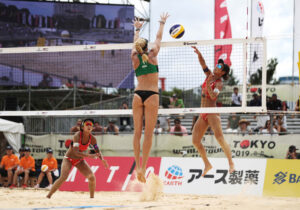
Daily training and mental discipline
Success in beach volleyball relies heavily on daily training and mental discipline.
Both technical refinement and mental preparation are essential for improving performance in matches.
Below, we will introduce practice methods to improve your technique and tips to develop a strong mentality for the game.
Practice methods to improve technique
-
Practice basic techniques : Practice basic techniques such as serving, receiving, setting, spiking, and blocking every day to improve the accuracy of your form. In particular, it is important to focus on techniques specific to beach volleyball.
-
Game Simulation : Practice as you would in a real game and expand your play by experimenting with different tactics and strategies. You will deepen your collaboration with partners and develop your communication skills at the same time.
-
Conditioning : In order to condition your body, include running, swimming, weight training, etc. Training to get used to moving on sand is especially effective.
Tips to develop a strong mentality for matches
-
Goal Setting : Set short-term and long-term goals and identify steps to achieve them. Build confidence by accumulating small successes.
-
Positive Self-Talk : Negative thoughts about yourself will reduce your performance. Use positive words to encourage yourself and increase your self-efficacy.
-
How to cope under pressure : Learn how to cope in situations where you feel tense or under pressure. We will practice deep breathing, relaxation techniques, and concentration exercises.
-
Mental training : Improve your mental focus with visualization and meditation. Having a mental picture of a successful play will have a positive impact on your actual play.
-
Learning from failure : Treat failures and setbacks in competition as learning opportunities and use them for the next time. Trying new techniques and tactics without fear of failure and gaining experience will lead to growth.
By honing your technique through daily training and strengthening your mind through mental training, you will be able to perform at your best in beach volleyball matches.
A commitment to personal growth and a positive mindset are the keys to success in the game.
summary
Improving your beach volleyball skills and succeeding in matches comes from daily practice and mental discipline.
It is important to hone your skills through a multifaceted approach, from repeated practice of basic techniques to game simulation and conditioning.
In addition, beach volleyball’s unique techniques and tactical understanding of how to find the opponent’s weaknesses and make the most of your own strengths are essential in order to make a difference in the match.
Psychologically, aspects such as goal setting, positive self-talk, coping under pressure, mental training, and learning from failure build a strong competitive mentality.
The path to success is not built overnight. By honing your technique and strengthening yourself mentally through daily training, you will be ready to perform at your best in a beach volleyball match.
Have a positive mindset and see failure as an opportunity for growth. And constantly striving for self-improvement is the key to growth and success as a beach volleyball player.
Through constant efforts towards self-development and close communication with teammates and coaches, you will be able to get closer to achieving your goals in beach volleyball.
